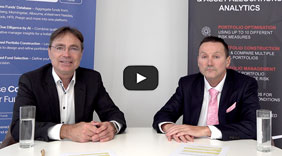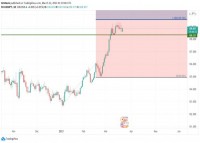|
The Math Behind Spread Arbitrage In order to understand how a strategy can be uncorrelated to the performance of equity markets and properly assess risk in an investment, professional investors might consider the strategic drivers of each investment. Spread arbitrage programs often determine trade execution through the use of mathematical probability tables that consider relationships between related products, time frames and pricing and may benefit when prices of related products temporarily dislocate but then revert back to the mean.1 “Spreads can trade higher or lower than a mean, but, in the normal course of events, they work back to a mean.” Schap wrote in his Spread Trading book, highlighting the core strategic driver of the strategy. Spread Prices Can Widen and Contract In Trend Trading Behavior Spread price variance, like outright markets, have been known to trend in price, dislocating from a price mean and potentially reverting to that mean (see related comments by Emil van Essen in this issue’s “manager profile”). “One (contract price) can be trending in one direction, while another trends in the other direction,” noted Schap in his book. In effect, spread trading can be subject to price momentum and persistence, just not in outright markets but rather in price relationships between contract months or related commodities. It is important to note that the spread trade might rely on one “leg” of their trade to revert back to the mean of its normal price relationship while the other leg remains relatively consistent in price, which is sometimes utilized by program managers with the goal to provide protection against exposure to the overall market moves. For example, the spread program outlined in this example is only a play on the relationship between oil and gasoline, not in the overall direction of the energy market either higher or lower. Thus, if an outside market force influenced the overall price of the energy market, taking the price of both oil and gasoline dramatically higher, the spread strategy typically does not desire exposure to the overall market move, but rather only the relationship in price between related products. This is not to say a spread strategy is less risky than an outright long or short position often taken by a trend following program, it is to say that the risks and market environments that influence performance can be different. “What matters is that both trends responding to the same set of economic drivers,” Schap said, highlighting the importance of strategic performance drivers when evaluating strategies. “They (spreads) exhibit a structure that responds to economic drivers.” Strategy Risk Considerations It is important to note in any mathematical algorithm there are points at which the strategy changes and historically consistent price relationships no longer “work.” One risk in the strategy is when prices dislocate based on historical probability tables they do not revert back to the mean. This is where the phrase “past performance is not indicative of future results” is provided meaning. Many economists have indicated that markets are so efficient that such opportunity for spread arbitrage may be limited, while other economic voices, such as MIT’s Andrew Lo, note that while market places may be efficient, decisions of market participants can be irrational – resulting in irrational market price movement.4 Indications are the market environments are constantly changing and risk management is tested when the formula and probability tables no longer apply to a given market environment. When considering risk, it is also important to note that macro strategy risk is different from more complicated factors not outlined in this document involved with individual manager risk, to which investors should be aware. Footnotes and additional reading:
CFTC RISK DISCLOSURE: PAST PERFORMANCE IS NOT INDICATIVE OF FUTURE RESULTS. THE RISK OF LOSS IN TRADING COMMODITIES CAN BE SUBSTANTIAL. YOU SHOULD THEREFORE CAREFULLY CONSIDER WHETHER SUCH TRADING IS SUITABLE FOR YOU IN LIGHT OF YOUR FINANCIAL CONDITION. THE HIGH DEGREE OF LEVERAGE THAT IS OFTEN OBTAINABLE IN COMMODITY TRADING CAN WORK AGAINST YOU AS WELL AS FOR YOU. THE USE OF LEVERAGE CAN LEAD TO LARGE LOSSES AS WELL AS GAINS. YOU COULD LOOSE ALL OF YOUR INVESTMENT OR MORE THAN YOU INITIALLY INVEST. IN SOME CASES, MANAGED COMMODITY ACCOUNTS ARE SUBJECT TO SUBSTANTIAL CHARGES FOR MANAGEMENT AND ADVISORY FEES. IT MAY BE NECESSARY FOR THOSE ACCOUNTS THAT ARE SUBJECT TO THESE CHARGES TO MAKE SUBSTANTIAL TRADING PROFITS TO AVOID DEPLETION OR EXHAUSTION OF THEIR ASSETS. THE DISCLOSURE DOCUMENT CONTAINS A COMPLETE DESCRIPTION OF THE PRINCIPAL RISK FACTORS AND EACH FEE TO BE CHARGED TO YOUR ACCOUNT BY THE COMMODITY TRADING ADVISOR ("CTA"). THE REGULATIONS OF THE COMMODITY FUTURES TRADING COMMISSION ("CFTC") REQUIRE THAT PROSPECTIVE CUSTOMERS OF A CTA RECEIVE A DISCLOSURE DOCUMENT WHEN THEY ARE SOLICITED TO ENTER INTO AN AGREEMENT WHEREBY THE CTA WILL DIRECT OR GUIDE THE CLIENT'S COMMODITY INTEREST TRADING AND THAT CERTAIN RISK FACTORS BE HIGHLIGHTED. THIS DOCUMENT IS READILY ACCESSIBLE AT THIS SITE. THIS BRIEF STATEMENT CANNOT DISCLOSE ALL OF THE RISKS AND OTHER SIGNIFICANT ASPECTS OF THE COMMODITY MARKETS. THEREFORE, YOU SHOULD PROCEED DIRECTLY TO THE DISCLOSURE DOCUMENT AND STUDY IT CAREFULLY TO DETERMINE WHETHER SUCH TRADING IS APPROPRIATE FOR YOU IN LIGHT OF YOUR FINANCIAL CONDITION. YOU ARE ENCOURAGED TO ACCESS THE DISCLOSURE DOCUMENT. YOU WILL NOT INCUR ANY ADDITIONAL CHARGES BY ACCESSING THE DISCLOSURE DOCUMENT. YOU MAY ALSO REQUEST DELIVERY OF A HARD COPY OF THE DISCLOSURE DOCUMENT, WHICH WILL ALSO BE PROVIDED TO YOU AT NO ADDITIONAL COST. THE CFTC HAS NOT PASSED UPON THE MERITS OF PARTICIPATING IN ANY OF THESE TRADING PROGRAMS NOR ON THE ADEQUACY OR ACCURACY OF ANY OF THESE DISCLOSURE DOCUMENTS. OTHER DISCLOSURE STATEMENTS ARE REQUIRED TO BE PROVIDED YOU BEFORE A COMMODITY ACCOUNT MAY BE OPENED FOR YOU. MUCH OF THE DATA CONTAINED IN THIS REPORT IS TAKEN FROM SOURCES WHICH COULD DEPEND ON THE CTA TO SELF REPORT THEIR INFORMATION AND OR PERFORMANCE. AS SUCH, WHILE THE INFORMATION IN THIS REPORT AND REGARDING ALL CTA COMMUNICATION IS BELIEVED TO BE RELIABLE AND ACCURATE, NOT WARANTEE RELATIVE TO SAME IS AVAILABLE. THE AUTHOR IS REGISTERED WITH THE NATIONAL FUTURES ASSOCIATION. |
|
This article was published in Opalesque Futures Intelligence.
|





 RSS
RSS










